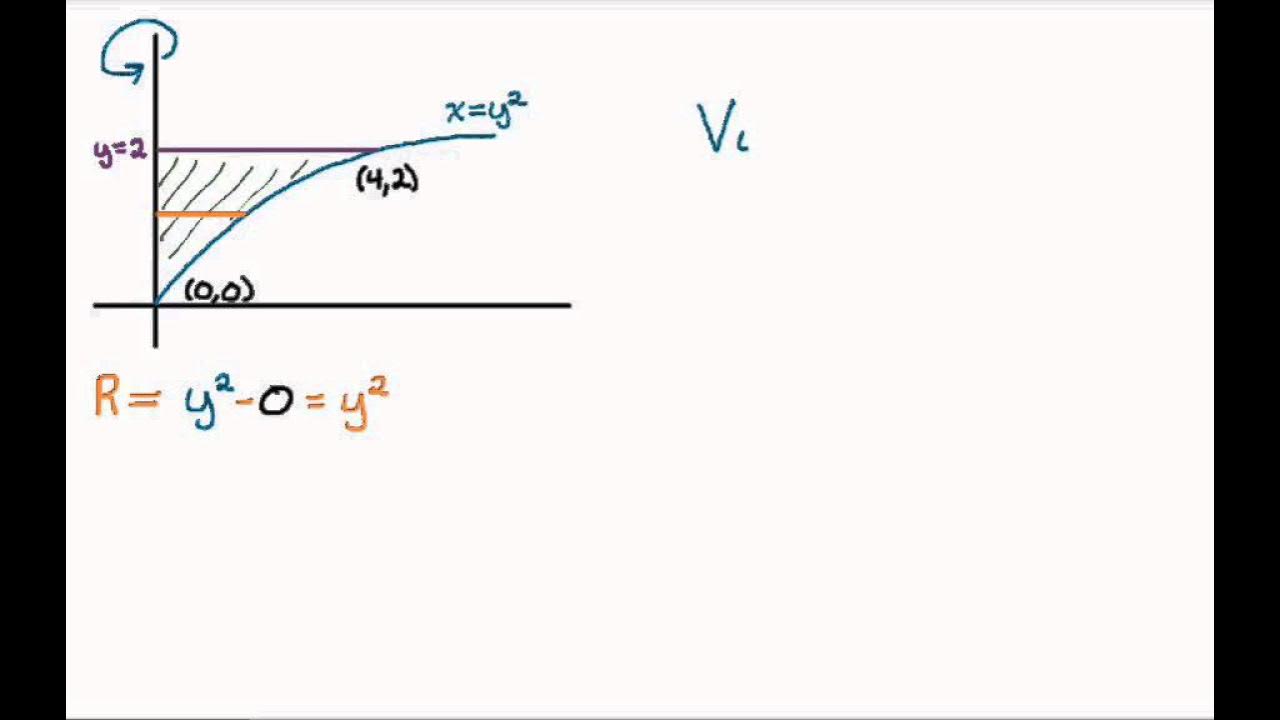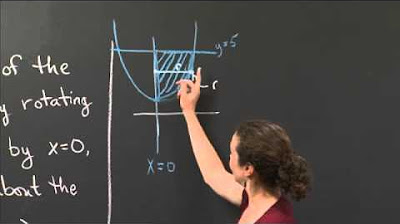Volume with cross sections perpendicular to y-axis | AP Calculus AB | Khan Academy
TLDRThis instructional video guides viewers through the process of calculating the volume of a solid defined by a region R in the first quadrant, bounded by the curve y = 4sqrt(9-x) and the coordinate axes. The solid's cross-sections, perpendicular to the y-axis, are rectangles with bases within R and heights equal to their corresponding y-values. The instructor demonstrates how to express the solid's volume as a definite integral by first transforming the equation to express x in terms of y, leading to the integral of y * (9 - y^2/16) from y=0 to y=12. This approach simplifies the volume calculation, making it solvable without a calculator by integrating a polynomial in y.
Takeaways
- 📊 The region R is defined by the curve y = 4√(9 - x) and the axes in the first quadrant.
- 🚨 Region R serves as the base for a solid, with cross sections perpendicular to the y-axis being rectangles.
- 📈 The base of each rectangle lies within region R, and its height is equal to the y-value at that position.
- 🔨 To express the volume of the solid, one must use a definite integral involving the dimensions of these rectangles.
- 📖 The instructor demonstrates visualizing the solid and its cross sections to better understand the volume calculation.
- 🔧 Integration is chosen to be done with respect to y, making it necessary to express x in terms of y for the calculation.
- ⚙ Solving for x in terms of y involves manipulating the equation of the curve to isolate x.
- 📏 The definite integral to express the volume of the solid involves an expression with y, (9 - y^2/16), and dy.
- ⏱ The integration limits are from y = 0 to y = 12, based on the dimensions of the solid.
- 📝 The integral presented is solvable without a calculator, as it results in a polynomial in y when expanded.
Q & A
What is the region R defined by in the problem?
-The region R is defined by the equation y equals four times the square root of nine minus x, and it is enclosed by the axes in the first quadrant.
How is the solid described in relation to region R?
-The solid is described such that its base is region R, and for each y-value, the cross-section of the solid taken perpendicular to the y-axis is a rectangle with base lying in R and height equal to y.
What is the purpose of expressing the volume of the solid with a definite integral?
-The purpose of expressing the volume of the solid with a definite integral is to calculate the total volume by summing up the infinitesimal volumes of all the cross-sections across the entire height of the solid.
How does the instructor suggest visualizing the solid?
-The instructor suggests visualizing the solid by drawing the y-axis and x-axis, redrawing region R, and then imagining cross sections of the solid taken perpendicular to the y-axis with varying y-values.
What is the infinitesimal volume of a thin slice of the solid?
-The infinitesimal volume of a thin slice of the solid is given by the area of the base (which lies in R) times the height (y) times an infinitesimal depth (dy), represented as y * x * dy.
Why does the instructor recommend integrating with respect to y?
-The instructor recommends integrating with respect to y because the volume expression is already in terms of dy, making the integration process simpler and more straightforward.
How can x be expressed in terms of y?
-To express x in terms of y, we manipulate the equation y equals four times the square root of nine minus x. By dividing both sides by four and squaring both sides, we get y^2/16 = nine minus x, and then by multiplying by negative one and adding nine to both sides, we get nine minus y^2/16 = x.
What is the volume expression for the solid in terms of a definite integral?
-The volume expression for the solid in terms of a definite integral is the integral from y equals zero to y equals 12 of (9 - y^2/16) dy.
How can the definite integral for the volume of the solid be evaluated?
-The definite integral for the volume of the solid can be evaluated by taking the antiderivative of (9 - y^2/16) with respect to y, and then applying the limits of integration (0 to 12) to find the difference in the antiderivative values at these limits.
What is the significance of the definite integral in understanding the volume of the solid?
-The definite integral provides a mathematical way to calculate the volume of the solid by summing up the infinitesimal volumes of all the cross-sections. It is a fundamental concept in calculus that allows us to find the accumulated quantity, in this case, the total volume, by integrating over a given range.
Outlines
📐 Visualizing the Solid and Setting Up the Definite Integral
The paragraph begins with the instructor introducing a mathematical problem involving a solid formed by a region R in the first quadrant. The region R is defined by the equation y = 4√(9 - x^2) and is enclosed by the x and y axes. The instructor explains that the base of the solid is represented by region R, and for each y-value, the cross-section of the solid perpendicular to the y-axis is a rectangle with base in R and height y. The task is to express the volume of the solid using a definite integral. The instructor encourages the viewer to visualize the solid and attempts to draw it in perspective. The x-axis and y-axis are identified, and region R is redrawn. The cross-section of the solid is described as having its base on the curve corresponding to a specific y-value. The infinitesimal volume of a slice is discussed in terms of depth d y, and the process of integrating across all slices to find the total volume is introduced. The instructor suggests integrating with respect to y, as it is easier given the expression in terms of d y, and shows how to express x in terms of y by solving the equation for x. The volume of an infinitesimal slice is then expressed as y times (9 - y^2)/16 d y. The final step is to integrate from y = 0 to y = 12 to find the volume of the entire solid, which can be solved without a calculator by multiplying the terms by y and evaluating the resulting polynomial integral.
Mindmap
Keywords
💡Region R
💡Solid
💡Cross-section
💡Definite Integral
💡y-axis
💡x-axis
💡Infinitesimal depth
💡Volume
💡Integration
💡Antiderivative
💡Polynomial
Highlights
The problem involves finding the volume of a solid formed by a region R in the first quadrant.
Region R is enclosed by y = 4√(9-x) and the x and y axes.
The solid's cross-section perpendicular to the y-axis is a rectangle with base in R and height y.
The volume of the solid is to be expressed as a definite integral.
Visualization of the solid is attempted through drawing and perspective.
The base of the rectangle corresponds to the x-value on the curve y = 4√(9-x).
The infinitesimal volume of a slice is considered in terms of depth d y.
Integrating with respect to y is suggested as easier due to the presence of d y.
To integrate with respect to y, x must be expressed in terms of y.
The equation y/4 = √(9-x) is squared and manipulated to express x in terms of y.
The volume of an infinitesimal slice is given as y * (9 - y^2) / 16 * d y.
The definite integral to find the volume of the solid is from y=0 to y=12.
The definite integral can be solved without a calculator by integrating term by term.
The process demonstrates the application of integration in calculating the volume of complex solids.
The method highlights the importance of visualizing mathematical problems to aid in their solution.
The problem showcases the use of functions and their properties in determining geometric shapes and volumes.
The solution involves a combination of algebraic manipulation and integral calculus.
Transcripts
Browse More Related Video

Volume with cross sections: squares and rectangles (no graph) | AP Calculus AB | Khan Academy

Volume of Solids with Known Cross Sections

2009 AP Calculus AB Free Response #4

Volume of Revolution Examples - Vertical Axis

2010 AP Calculus AB Free Response #4

Volume of a Paraboloid via Disks | MIT 18.01SC Single Variable Calculus, Fall 2010
5.0 / 5 (0 votes)
Thanks for rating: